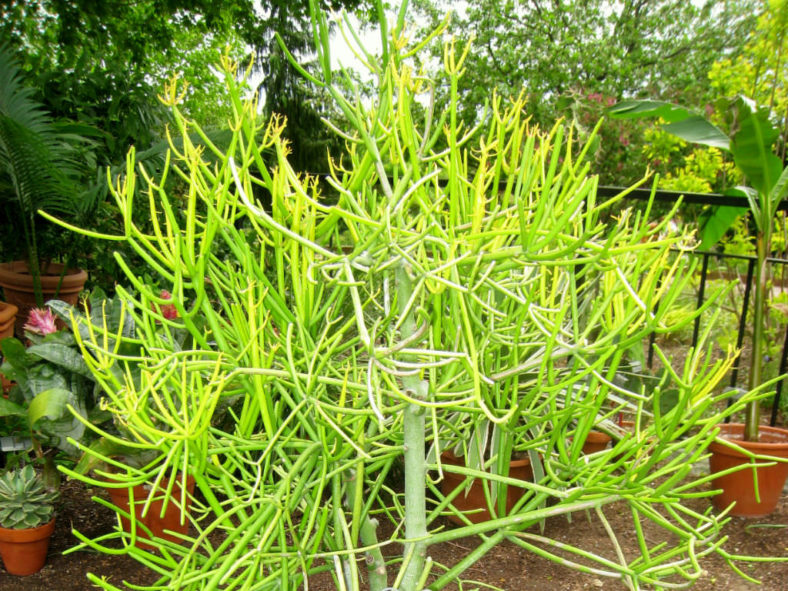Scientific Name
Euphorbia tirucalli L.
Common Name(s)
African Milk Bush, Finger Euphorbia, Finger Tree, Firestick Plants, Indian Tree Spurge, Milk Bush, Milk Hedge, Naked Lady, Pencil Bush, Pencil Cactus, Pencil Euphorbia, Pencil Tree, Petroleum Plant, Rubber Euphorbia, Rubber Hedge Euphorbia, Rubber Hedge Plant, Sticks on Fire, Fire Stick Plant
Synonym(s)
Arthrothamnus tirucalli, Tirucalia indica, Tirucalia tirucalli
Scientific Classification
Family: Euphorbiaceae
Subfamily: Euphorbioideae
Tribe: Euphorbieae
Subtribe: Euphorbiinae
Genus: Euphorbia
Etymology
The specific epithet "tirucalli" (pronounced "tee-roo-KAL-ee") was chosen by Linnaeus from the words used by the locals of Malabar in Southern India, "tiru" meaning "good," and "kalli" referring to the medicinal qualities of the various species of the genus Euphorbia.
Origin
Euphorbia tirucalli is native to Africa.
Description
Euphorbia tirucalli is a succulent shrub or small tree that usually grows up to 16.5 feet (5 m) tall but occasionally may reach up to 33 feet (10 m). The stems are fleshy, smooth, green, cylindrical, measuring up to 0.3 inches (0.8 cm) in diameter, and often produced in whorls. When new, the stems bear leaves that soon drop. The leaves can grow up to 1 inch (2.5 cm) long.
The yellow flowers are inconspicuous and carried in clusters at the tips of the short branches or the angles of the branches. They appear during the cooler months of the year. The fruits are tripartite capsules, pale green with a pink tinge, and covered with soft hairs. They can reach a diameter of 0.5 inches (1.3 cm).

Hardiness
USDA hardiness zones 10a to 11b: from 30°F (-1.1°C) to 50°F (10°C).
How to Grow and Care
Euphorbias are very easy to care for. These plants require a little pampering to become established, but once they are, they are self-sufficient. More die from overcare and watering than from neglect. Euphorbias need well-draining soil and ample sunlight. They are not particular about soil pH but cannot tolerate wet soil. Unlike most succulents, Euphorbia does not handle long periods of drought well. It may need weekly watering during the summer. Water whenever the top several inches of the soil are dry. Water deeply, but avoid letting them sit in wet soil, as this can cause root rot. Add some organic matter or fertilizer to the planting hole. Feed with a half-strength fertilizer monthly if you are growing them in containers or your soil is poor.
These succulents can be grown from seed, but they can be difficult to germinate (or even find). They are usually propagated by cuttings. This can be tricky because of the exuding sap. Rooting hormone is recommended with Euphorbias. They tend to grow problem-free, but a few pests and diseases are worth being alert for.
Learn more at How to Grow and Care for Euphorbia.
Toxicity
Euphorbia tirucalli contains a milky sap that is highly irritating to the skin and mucosa and is toxic. Exposure to it can cause blindness lasting several days. Skin contact causes severe irritation, redness, and a burning sensation. If ingested, it can cause burns to the mouth, lips, and tongue. You should wear eye protection gear and gloves to handle the plant.
Cultivars
Links
- Back to genus Euphorbia
- Succupedia: Browse succulents by Scientific Name, Common Name, Genus, Family, USDA Hardiness Zone, Origin, or cacti by Genus
Photo Gallery
Click on a photo to see a larger version.


